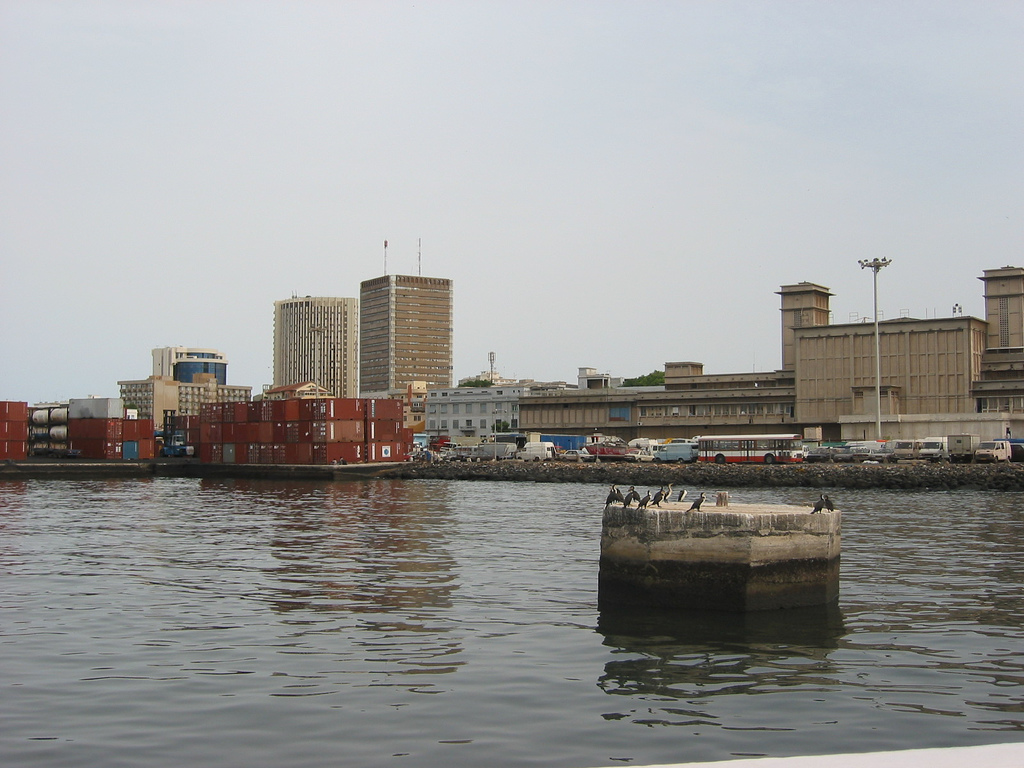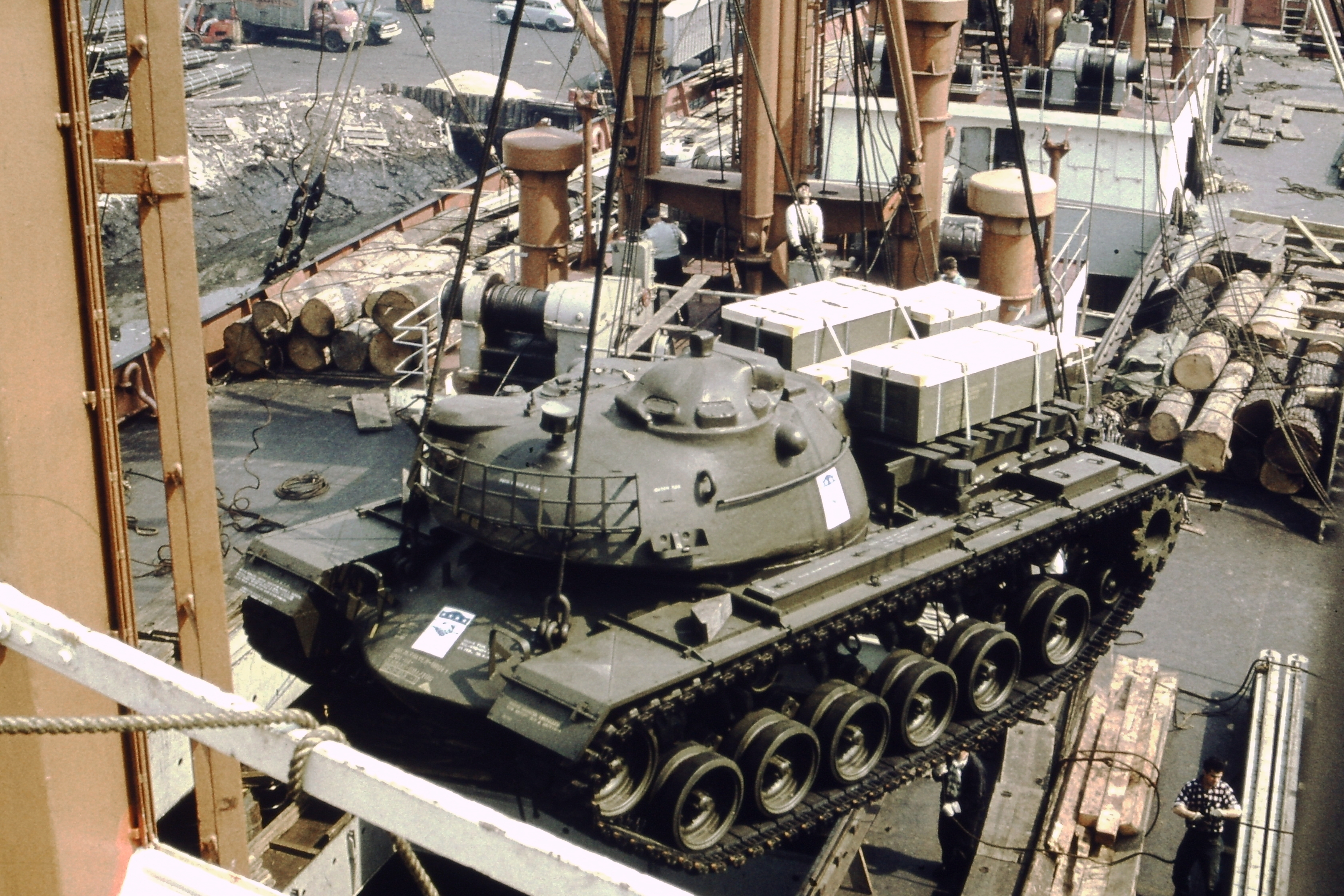|
Port Of Bissau
The Port of Bissau, also known as Porto Pidjiguiti, is the chief port of Guinea-Bissau. Located on Geba River, it serves the capital of Bissau. It has two piers and a jetty. The port's Pidjiguiti docks were the site of the Pidjiguiti massacre on 3 August 1959. A light on Bissau Cathedral is maintained by the harbourmaster. Description The port is situated on Geba River. Its channel has a depth of to and cargo pier of to . It has crane facilities for up to 50 tonnes. The cargo port has two piers, a southwest pier and, a newer one on the northeast. The newer "T" shaped long pier was built in 1993. The jetty connecting it is , and provides access to the shore. Thirty years before 2013, the channel was dredged to provide a draft of . However, the present draft is said to be . Bissau Cathedral tower houses a light which guides ships through the Geba River estuary to the Port of Bissau. The light is maintained by the Capitania dos Portos, Serviços de Marinha. History The port ... [...More Info...] [...Related Items...] OR: [Wikipedia] [Google] [Baidu] |
Guinea-Bissau
Guinea-Bissau ( ; pt, Guiné-Bissau; ff, italic=no, 𞤘𞤭𞤲𞤫 𞤄𞤭𞤧𞤢𞥄𞤱𞤮, Gine-Bisaawo, script=Adlm; Mandinka: ''Gine-Bisawo''), officially the Republic of Guinea-Bissau ( pt, República da Guiné-Bissau, links=no ), is a country in West Africa that covers with an estimated population of 1,726,000. It borders Senegal to the north and Guinea to the south-east. Guinea-Bissau was once part of the kingdom of Kaabu, as well as part of the Mali Empire. Parts of this kingdom persisted until the 18th century, while a few others were under some rule by the Portuguese Empire since the 16th century. In the 19th century, it was colonised as Portuguese Guinea. Portuguese control was restricted and weak until the early 20th century with the pacification campaigns, these campaigns solidified Portuguese sovereignty in the area. The final Portuguese victory over the remaining bastion of mainland resistance, the Papel ruled Kingdom of Bissau in 1915 by the Portu ... [...More Info...] [...Related Items...] OR: [Wikipedia] [Google] [Baidu] |
Harbourmaster
A harbourmaster (or harbormaster, see spelling differences) is an official responsible for enforcing the regulations of a particular harbour or port, in order to ensure the safety of navigation, the security of the harbour and the correct operation of the port facilities. Responsibilities Harbourmasters are normally responsible for issuing local safety information sometimes known as notice to mariners. They may also oversee the maintenance and provision of navigational aids within the port, co-ordinate responses to emergencies, inspect vessels and oversee pilotage services. The harbourmaster may have legal power to detain, caution or even arrest persons committing an offence within the port or tidal range of the port's responsibilities. An example of this is the team of harbourmasters employed by the Port of London Authority who are empowered to undertake an enforcement role. Actions that a harbourmaster may investigate include criminal acts, immigration, customs and excise, m ... [...More Info...] [...Related Items...] OR: [Wikipedia] [Google] [Baidu] |
Ports And Harbours In Africa
A port is a maritime facility comprising one or more wharves or loading areas, where ships load and discharge cargo and passengers. Although usually situated on a sea coast or estuary, ports can also be found far inland, such as Hamburg, Manchester and Duluth; these access the sea via rivers or canals. Because of their roles as ports of entry for immigrants as well as soldiers in wartime, many port cities have experienced dramatic multi-ethnic and multicultural changes throughout their histories. Ports are extremely important to the global economy; 70% of global merchandise trade by value passes through a port. For this reason, ports are also often densely populated settlements that provide the labor for processing and handling goods and related services for the ports. Today by far the greatest growth in port development is in Asia, the continent with some of the world's largest and busiest ports, such as Singapore and the Chinese ports of Shanghai and Ningbo-Zhou ... [...More Info...] [...Related Items...] OR: [Wikipedia] [Google] [Baidu] |
Autonomous Port Of Dakar
The Autonomous Port of Dakar (French: ''Port autonome de Dakar'', abbreviation: ''PAD'') is a Senegalese public enterprise which is headquartered in Dakar, located in the east of city. Thanks to the strategic position that gives it a sheltered harbor, it is now the third largest port in West Africa after the Autonomous Port of Abidjan and the Port of Lagos It is also the ninth-largest port on the African continent. The port has one of the largest deep-water seaports along the West African coast. Its deep-draft structure and access channel allows round-the-clock access to the port. Its current infrastructure includes tanker vessel loading and unloading terminals, a container terminal with a storage capacity of 3000 20-foot-equivalent units, a cereals and fishing port, a dedicated phosphate terminal and a privately run ship repair facility. The port's location at the extreme western point of Africa, at the crossroad of the major sea-lanes linking Europe to South America, makes i ... [...More Info...] [...Related Items...] OR: [Wikipedia] [Google] [Baidu] |
African Party For The Independence Of Guinea And Cape Verde
The African Party for the Independence of Guinea and Cape Verde ( pt, Partido Africano para a Independência da Guiné e Cabo Verde, PAIGC) is a political party in Guinea-Bissau. Originally formed to peacefully campaign for independence from Portugal, the party turned to armed conflict in the 1960s and was one of the belligerents in the Guinea-Bissau War of Independence. Towards the end of the war, the party established a socialist one-party state, which remained intact until multi-party democracy was introduced in the early 1990s. Although the party won the first multi-party elections in 1994, it was removed from power in the 1999–2000 elections. However, it returned to office after winning parliamentary elections in 2004 and presidential elections in 2005, since which it has remained the largest party in the National People's Assembly. The PAIGC also governed Cape Verde, from its independence in 1975 to 1980. After the military coup in Guinea-Bissau in 1980, the Cape ... [...More Info...] [...Related Items...] OR: [Wikipedia] [Google] [Baidu] |
Stevedore
A stevedore (), also called a longshoreman, a docker or a dockworker, is a waterfront manual laborer who is involved in loading and unloading ships, trucks, trains or airplanes. After the shipping container revolution of the 1960s, the number of dockworkers required declined by over 90%. Etymology The word ''stevedore'' originated in Portugal or Spain, and entered the English language through its use by sailors. It started as a phonetic spelling of ''estivador'' (Portuguese) or ''estibador'' (Spanish), meaning ''a man who loads ships and stows cargo'', which was the original meaning of ''stevedore'' (though there is a secondary meaning of "a man who stuffs" in Spanish); compare Latin ''stīpāre'' meaning ''to stuff'', as in ''to fill with stuffing''. In Ancient and modern Greek, the verb στοιβάζω (stevazo) means pile up. In the United Kingdom, people who load and unload ships are usually called ''dockers''; in Australia, they are called ''dockers'' or ''wharfies''; and ... [...More Info...] [...Related Items...] OR: [Wikipedia] [Google] [Baidu] |
Bauxite
Bauxite is a sedimentary rock with a relatively high aluminium content. It is the world's main source of aluminium and gallium. Bauxite consists mostly of the aluminium minerals gibbsite (Al(OH)3), boehmite (γ-AlO(OH)) and diaspore (α-AlO(OH)), mixed with the two iron oxides goethite (FeO(OH)) and haematite (Fe2O3), the aluminium clay mineral kaolinite (Al2Si2O5(OH)4) and small amounts of anatase (TiO2) and ilmenite (FeTiO3 or FeO.TiO2). Bauxite appears dull in luster and is reddish-brown, white, or tan. In 1821, the French geologist Pierre Berthier discovered bauxite near the village of Les Baux in Provence, southern France. Formation Numerous classification schemes have been proposed for bauxite but, , there was no consensus. Vadász (1951) distinguished lateritic bauxites (silicate bauxites) from karst bauxite ores (carbonate bauxites): * The carbonate bauxites occur predominantly in Europe, Guyana, Suriname, and Jamaica above carbonate rocks (limestone and do ... [...More Info...] [...Related Items...] OR: [Wikipedia] [Google] [Baidu] |
Mining Industry Of Guinea-Bissau
Mining in Guinea-Bissau is limited to small-scale production of construction materials, such as clays, granite, limestone, and sand and gravel.Omayra Bermúdez-Lugo"The Mineral Industries of The Gambia, Guinea-Bissau, and Senegal" ''2005 Minerals Yearbook''. U.S. Geological Survey (August 2007). ''This article incorporates text from this U.S. government source, which is in the public domain''. The country's prospective minerals include bauxite, diamond, gold, heavy minerals, petroleum, and phosphate rock. Phosphate Phosphate deposits were identified about 40 years ago in the region of Farim. Feasibility studies were completed in the 1980s, but since then no company has been able to begin exploitation. The Farim phosphate rock deposit had estimated resources of more than 166 Mt at a grade of 29% P4O10. Red Back Mining Inc. through its subsidiary Champion Industrial Minerals (CIM) held a mining lease and after completing a technical and market evaluation in 2003, the company con ... [...More Info...] [...Related Items...] OR: [Wikipedia] [Google] [Baidu] |
Estuary
An estuary is a partially enclosed coastal body of brackish water with one or more rivers or streams flowing into it, and with a free connection to the open sea. Estuaries form a transition zone between river environments and maritime environments and are an example of an ecotone. Estuaries are subject both to marine influences such as tides, waves, and the influx of saline water, and to fluvial influences such as flows of freshwater and sediment. The mixing of seawater and freshwater provides high levels of nutrients both in the water column and in sediment, making estuaries among the most productive natural habitats in the world. Most existing estuaries formed during the Holocene epoch with the flooding of river-eroded or glacially scoured valleys when the sea level began to rise about 10,000–12,000 years ago. Estuaries are typically classified according to their geomorphological features or to water-circulation patterns. They can have many different names, such as bays, ... [...More Info...] [...Related Items...] OR: [Wikipedia] [Google] [Baidu] |
Bissau
Bissau () is the capital, and largest city of Guinea-Bissau. Bissau had a population of 492,004. Bissau is located on the Geba River estuary, off the Atlantic Ocean, and is Guinea-Bissau's largest city, major port, and its administrative and military centre. Etymology The term Bissau may have come from the name of a clan N'nssassun, in its plural form Bôssassun.direct link to pdf Intchassu (Bôssassu) was the name given to the nephew of King Mecau—the first sovereign of the island of Bissau—, son of his sister Pungenhum. Bôssassu formed a clan of the Papel peoples. History The city was founded in 1687 by Portugal as a fortified port and trading center. In 1942 the capital of Portuguese Guinea was transferred from Bolama to Bissau. After the declaration of independence by the anti-colonial guerrillas of PAIGC in 1973, the capital of the rebel territories was declared to be Madina do Boe, while Bissau remained the colonial capital. When Portugal granted independence, fo ... [...More Info...] [...Related Items...] OR: [Wikipedia] [Google] [Baidu] |
Porto De Bissau 03
Porto or Oporto () is the second-largest city in Portugal, the capital of the Porto District, and one of the Iberian Peninsula's major urban areas. Porto city proper, which is the entire municipality of Porto, is small compared to its metropolitan area, with an estimated population of just 231,800 people in a municipality with only 41.42 km2. Porto's metropolitan area has around 1.7 million people (2021) in an area of ,Demographia: World Urban Areas March 2010 making it the second-largest urban area in Portugal. It is recognized as a global city with a Gamma + rating from the |




_(2).jpg)



